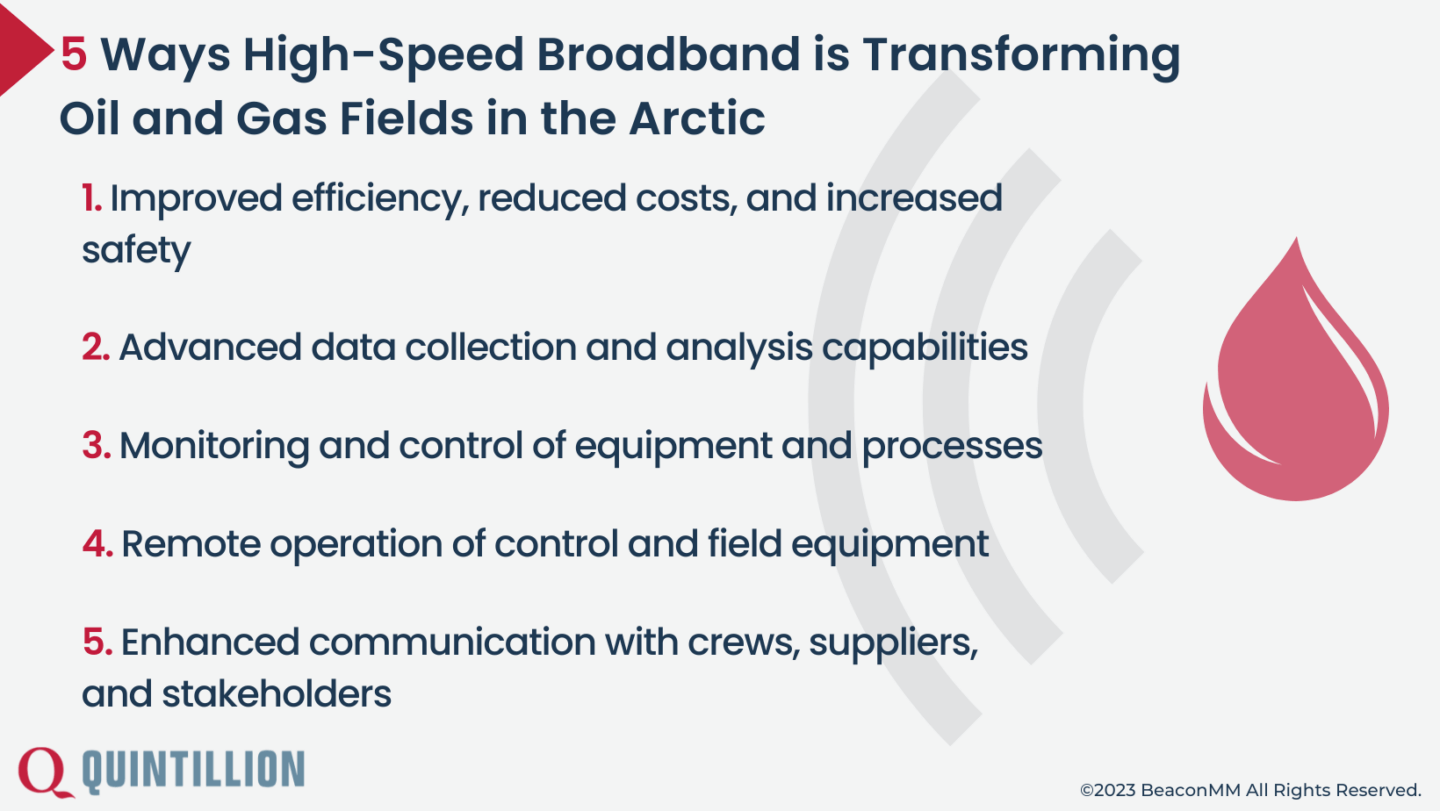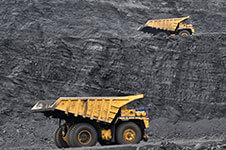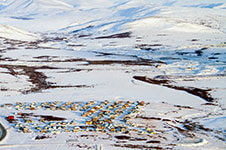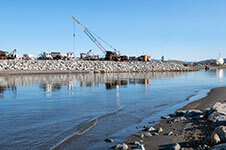The oil and gas industry is absolutely essential to the health of our global economy – and has been for decades. Correspondingly, as our technology continues to advance at an exponential rate, industry has had to change along with it. In our modern era, the oil and gas industry has shifted to embrace digital technologies in an effort to maximize efficiency and output on a large scale. This evolution in technology has led to the development of the digital oil field, a concept that has become exceedingly vital in the Arctic region, particularly in the Prudhoe Bay oil fields.
The Arctic region has always presented a unique challenge for the oil and gas industry. This harsh environment and its terrain make it difficult for companies to operate in the area, especially in remote regions. However, with such vast, untapped resources available in the Arctic, this makes the region an attractive location for oil and gas exploration. Located on Alaska’s Northern Slope, the Prudhoe Bay oil fields are one such area. In fact, these oil fields have been open for oil production since the late 1970s, and have continued to supply vital energy to the United States.
How High-Speed Broadband Has and Will Impact the Oil and Gas Fields in the Arctic

High-speed broadband has aided oil and gas exploration over the years in many ways, especially in the Arctic region. With the implementation of digital technologies and the help of high-speed broadband, this has allowed companies to procure vast amounts of data and analyze critical findings in real time. In addition, this has not only led to improved efficiency but also to reduced costs and increased safety for those working in the harsh conditions of remote Arctic regions.
One primary area where high-speed broadband has revolutionized the industry is with the monitoring and control of equipment and operational processes. High-speed broadband, along with high-tech sensors and monitoring devices, allow oil and gas companies to collect data and perform analysis on critical metrics. These include pressure and temperature fluctuations as well as fluid levels and flow rates. To identify possible issues before they cause a halt to production, essential data is then transmitted to a data control center via high-speed broadband. There, it can be analyzed in real time to help identify problems. This helps minimize downtime and mitigate the risk of accidents.
High-speed broadband is also making a huge impact in the remote operation of equipment. In the past, machine and equipment operation would require workers to be physically present on site. Today, things have changed. With the implementation of high-speed broadband, combined with remote technologies from a safe, central location, operators are now able to control equipment without direct contact. This has effectively mitigated the need for workers to be physically present in hazardous locations, while opening the door for more operations in remote locations.
Additionally, it’s no secret that communication efforts in remote regions of the Arctic have always been problematic. However, high-speed broadband is transforming how businesses communicate in Arctic oil and gas fields. With the ability to quickly perform large data transmissions reliably, companies can communicate with all assets in the field, including workers, suppliers, and other stakeholders. This improved collaboration, along with the ability to streamline processes, can help to minimize the risk of miscommunication and keep workflow on track.
Today, there are no signs of digital technology slowing down. With high-speed broadband already transforming the oil and gas industry in the Arctic region, and with the use of digital technologies allowing companies to collect and analyze data in real-time, it’s likely that the use of high-speed broadband in the Arctic oil and gas fields will become even more widespread in the future, leading to further improvements in efficiency, safety, and increased profitability.
How Quintillion Works With Oil and Gas Companies
Access to remote regions in Alaska can be a huge challenge for any business operation. But in recent years, the development of the digital oil field has led to revolutionizing operations in Prudhoe Bay. For example, through the use of digital technologies, companies are now able to collect and analyze vast amounts of data, allowing them to optimize production and reduce costs. This is where Quintillion’s telecommunications infrastructure comes in. Our existing fiber network has the ability to extend into remote locations, providing leading oil and gas producers with essential bandwidth for maintaining mobility and running end-user devices. At the end of the day, our high-quality and cost-effective fiber will not only enhance communication but also improve operations for oil and gas companies operating in the Arctic.
At Quintillion, part of our mission includes forming unique partnerships. As such, we work closely with companies in Prudhoe Bay to offer customized telecommunications solutions to meet their specific needs. In fact, some internet service providers are even using our terrestrial capacity to provide corporate business and man-camp/morale network services. This has helped to improve morale in remote conditions, enhance communication and productivity, and make operations in the Arctic much more efficient and cost-effective.
Safety is always a huge concern for oil and gas companies, and remote regions can make safety compliance a true challenge. However, the use of digital technologies has also helped to improve safety in the Prudhoe Bay oil fields. For example, real-time data analysis can hone in on potential problems before they cause harm to individuals, the environment, or machinery. This allows companies to be proactive and take the appropriate measures to ensure the safety of their investment, workers, and the environment.
In todays interconnected technological landscape, the digital oil field has become an essential component of the oil and gas industry, particularly in the Arctic region. And Quintillion’s telecommunications infrastructure is playing a pivotal role in helping oil and gas companies to optimize production, reduce costs, and improve safety in Prudhoe Bay. As the industry continues to evolve, and as oil and gas exploration operates further from shore, it’s clear that digital technologies will become increasingly vital for future operations.
Digital Technologies and Their Benefits for Oil and Gas Companies
It’s hard to put a universal label on “digital technology,” as there is a multitude of applications that compose this branch of tech space. But each moving part under the umbrella of digital technology serves a vital purpose. In fact, without some of the following technologies, oil and gas exploration in the Arctic would be next to impossible.
Custom Networks
Custom networks are intentionally designed to meet a company’s specific needs, thus “customized” to handle the unique requirements of an organization. A few of these requirements may include the type of data being transmitted, the location of the company’s offices and equipment, and the number of users. In addition, custom networks also help to facilitate the optimization of communication and operations for oil and gas companies, and this can ultimately lead to improved efficiency and reduced costs.
Dark Fiber
Dark fiber isn’t as ominous as it sounds. The fact is, this technology simply refers to unused or “dark” optical fiber cables that are available for lease to companies, and this technology provides a service that many companies find extremely valuable. Dark fiber cables are often used to create a private network for a company, allowing them to transmit large amounts of data at high speeds. Additionally, dark fiber is also beneficial for oil and gas companies, as it allows for more control over their network, offering heightened security and reliability.
Corporate WAN
A corporate WAN (Wide Area Network) is a network that connects the different locations of a company. Depending on the type of business, locations can be spread all over the planet. However, for most companies, this typically includes offices, data centers, and oil/gas fields. By connecting these locations through a corporate WAN, companies have the ability to streamline processes and enhance communication and collaboration.
Optical Wavelength Service (10G – 100G)
High-speed, dedicated point-to-point connections that provide a high level of security and reliability are known as optical wavelength services. These are typically used for transmitting large amounts of data quickly. Optical wavelength services also serve as a great benefit for oil and gas companies, as they offer enhanced speed, which allows for fast and efficient data transmission.
Ethernet Private Line (1 Mbps – 10 Gbps)
Much like an optical wavelength service, Ethernet private lines are dedicated point-to-point connections that provide secure, reliable, and high-speed data transmission. For enhanced security measures, these lines are also extremely beneficial for oil and gas companies. In addition, they also allow for faster, real-time data transmission and improved communication between locations.
Ethernet Virtual Private Line (1 Mbps – 10 Gbps)
Similar to Ethernet private lines, Ethernet virtual private lines are created using virtual connections rather than physical connections. This service offers an attractive option for oil and gas companies, as it also provides a high level of security and reliability. Correspondingly, Ethernet virtual private lines are also extremely beneficial for oil and gas companies as they allow for improved data transmission and collaboration.
Internet Access
It should go without saying that internet access is a vital service – one that provides access to the internet via a broadband connection. Without this service, many digital networking devices simply would not work at all. Thus, this service is essential for oil and gas companies, as it serves as the primary method of communication between stakeholders, suppliers, and customers, as well as being used heavily for research and information gathering.
Camp-Based Services
Working in remote areas can be lonely, boring, and sometimes bewildering – especially with little contact to the outside world. This makes camp-based services vital for keeping morale high when workers have downtime, and improving productivity when on the job. Essentially, camp-based services are designed to provide communication and entertainment services for workers living in remote or temporary camps, and may include internet access, phone service, and television.
Quintillion’s Future Plans in Partnering With Oil and Gas Companies
At Quintillion, we understand the benefit of partnering with oil and gas companies and improving communication infrastructure in the Arctic. These initiatives and strategic collaboration lead to the following:
Improved communication
We know that communication is key for businesses to function properly. Our innovative Arctic broadband network enables vital connectivity that all businesses operating in the Arctic rely on. And as a Broadband telecom company, we can provide customized network solutions to meet the specific needs of oil and gas companies.
Enhanced data transmission
High-speed data transmission is key to timely decision making in extreme conditions. And with increasing use of digital technology in the oil and gas industry, there is a growing need for high-speed data transmission. Broadband telecom companies operating in the Arctic can provide high-speed and reliable connections that can handle the large amounts of data generated by the industry.
With greater bandwidth, oil and gas producers are able to leverage this technology, including such items as video on the well pad and local Wi-Fi access for field service personnel.
Joint network development
Joint network development is the process of working with a telecommunications company to design and build a custom network to suit specific company requirements. Typically, this process involves a great deal of collaboration in order to develop these customs solutions. But this collaboration is essential for joint network development to be valuable for oil and gas companies. At the end of the day, this process allows oil and gas companies to create a highly functioning network that can improve all operational processes.
In the future, we can expect further advancements in broadband technology that will provide even more benefits for oil and gas companies. At Quintillion, we can say that the future of the digital oilfield is exciting and promising. As technology continues to advance, we can expect to see further innovation and advancements in technology driving improvements in efficiency, safety, and sustainability.
Want to learn more Quintillion’s subsea fiber optic cable system and how it’s bringing the gold standard of connectivity to the Alaska Arctic? Contact our team to get in touch or read the Quintillion blog to stay on top of the latest industry news.















